Analysis and action on living standards
2022-23 featured an array of tax and benefit changes, including the introduction then cancellation of a major tax rate rise, and three big cash payment schemes to help cover living costs. Tax and benefit policy in the financial year 2023-24 may prove to be less fickle, and in this spotlight we set out what is happening. Given the sky-high inflation of 2022, the key changes in April 2023 will include a particularly large benefit increase and a particularly notable tax threshold freeze.
The twin crises of Covid-19 and energy-price-driven inflation have had many impacts on tax and benefit policy. The need to service higher debt interest bills – among other factors – is taking tax as a share of GDP from 33 per cent in 2019-20 to around 37 per cent in 2022-23 and 2023-24, and specific spending policies are doing a critical job in supporting households through the cost of living crisis.
Here we take a quick look at five of the most important personal tax and benefit changes coming in 2023-24 that will directly affect household incomes.
The Spring Budget extended the Energy Price Guarantee, ensuring that the cap on the typical annual energy bill will remain at £2,500 in Q2 (while falling energy prices will hopefully start to deliver reductions from July). However, direct debit payments will rise for most households in April, with the ending of the £67 a month Energy Bills Support Scheme.
On the other hand, April will bring a 10.1 per cent increase to benefits such as the State Pension, Pension Credit, Child Benefit and Universal Credit. This follows the norm of uprating benefits each April in line with the previous September’s CPI inflation rate. In the case of the (old) State Pension, that will mean an annual rise of around £750 (from £7,400 to £8,140), while basic Universal Credit will rise from £4,020 to £4,420. The benefit cap will also rise – for the first time ever – going from £20,000 to £22,020 for parents or couples outside London, although these very welcome increases for over 100,000 households will still leave the cap lower in cash terms than when it was introduced in 2013.
As Figure 1 shows, even with the 10.1 per cent increase, though, basic benefit levels will not have caught up with the rise in the cost of living that has happened since Q1 2021. It is only next year, with a further uprating of perhaps 5 per cent, that the gap may close.
Figure 1: Benefit levels are not expected to catch up with recent price rises until April 2024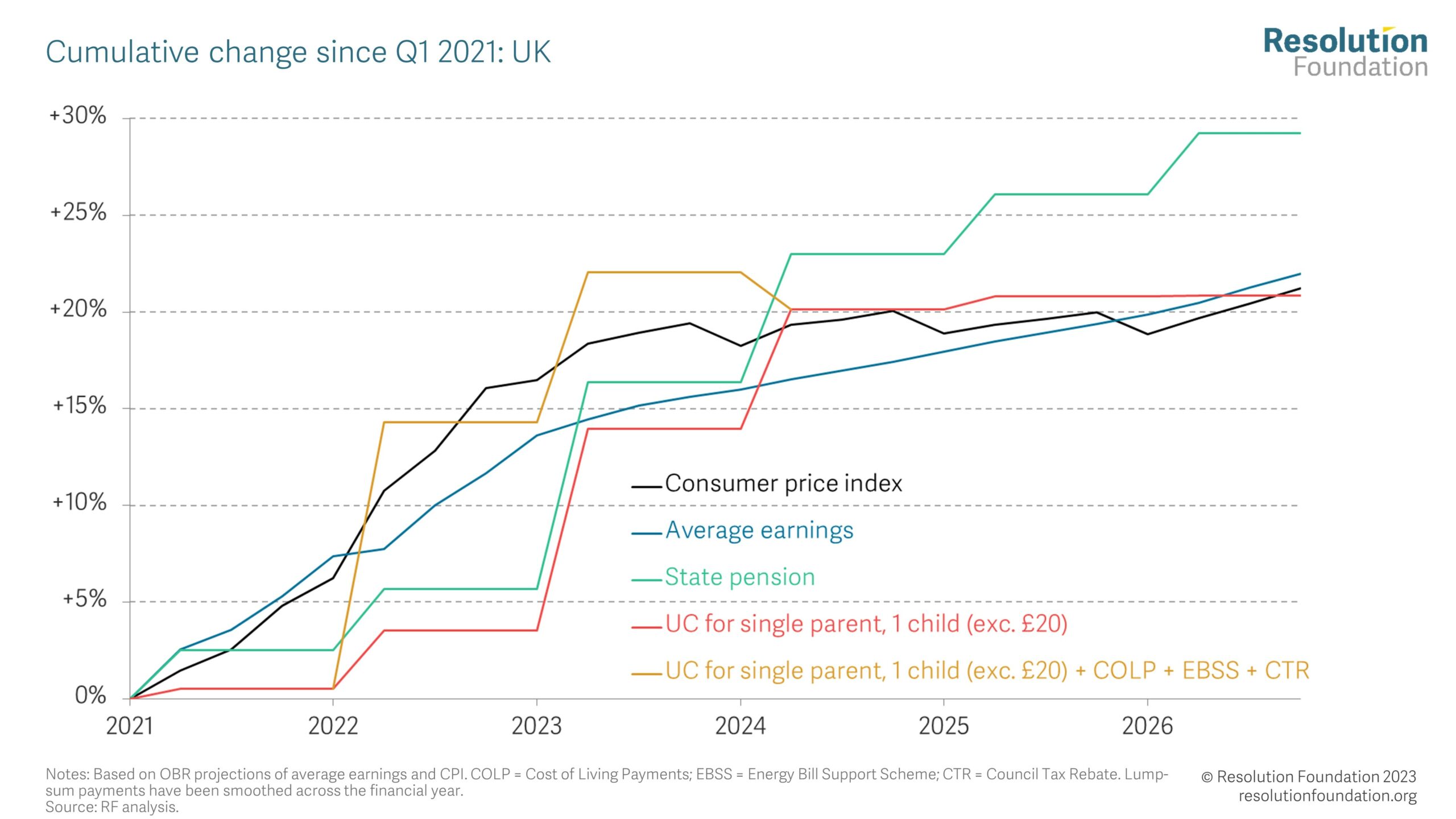
However, other forms of cash support are helping to bridge the gap created by delayed benefit uprating. Although the universal Energy Bills Support Scheme is ending (and the Council Tax Rebate was a one-off payment last spring), an enhanced set of Cost of Living Payments will provide £11 billion of support in 2023-24. 8 million households receiving means-tested benefits will get £301 between 25 April and 17 May, with similar payments in Autumn 2023 and Spring 2024 making a total of £900 over the year – or £75 a month – and there will be additional payments to pensioners and those on disability benefits. Figure 1 shows that such lump-sum cash payments are helping benefit payments keep up with overall inflation (although inflation has been higher for lower-income households) – but the fact that these payments do not vary with family size (or energy needs) makes them a somewhat blunt instrument.
Some taxes are going up in April. For one, the average Band D Council Tax bill in England is set to rise by 5.1 per cent – or £99 – from £1,966 to £2,065 (and in Wales there is a 5.8 per cent average rise, with comparable increases across Scotland). These increases are below the recent pace of inflation and average earnings growth, but such Council Tax rises are not expected to be a one-off. Between 2022-23 and 2027-28, English Council Tax bills may rise by 25 per cent, compared to price inflation of 7 per cent and average wage growth of 13 per cent. Council Tax is thirty years old on 1 April, and we should continue to question whether this unreformed semi-poll tax is a fair way of raising over £40 billion a year.
While Council Tax rises affect almost everyone, other tax rises will be more targeted. Three measures will together raise £2 billion a year in the medium-term:
In Scotland, the higher and top Income Tax rates will rise by 1 percentage point, to 42 and 47 per cent. Working in the other direction are the recently-announced increase in the pensions Annual Allowance and the removal of the Lifetime Allowance, which will together cost over £1 billion a year in the medium-term.
Perhaps the most important piece of personal tax policy in 2023-24, though, is the decision not to raise the starting point for Income Tax and personal National Insurance, nor the higher rate threshold. These remain frozen at £12,570 and £50,270 respectively, and are set not to rise before April 2028.
If the usual CPI uprating had happened this April, then those thresholds would be rising by 10.1 per cent to £13,840 and £55,340. For a basic-rate paying employee, that change would have been worth just over £400 (including National Insurance, or £250 without), while a higher-rate payer would have gained over £900 overall.
Figure 2: The six-year personal allowance freeze is projected to undo around half of the real-terms rise of the 2010s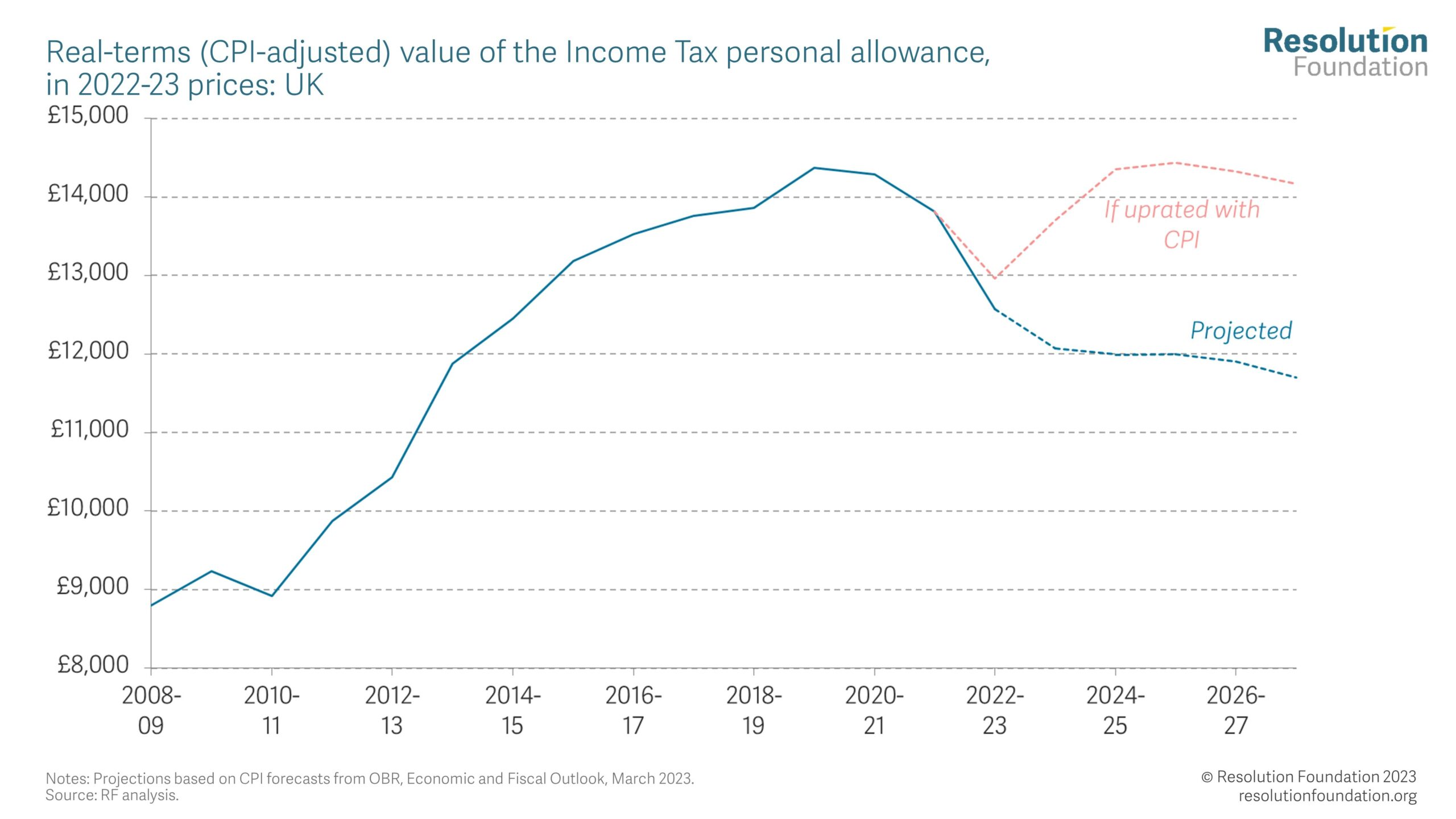
As Figure 2 shows, the six-year freeze in the Income Tax personal allowance means that its real value is projected to fall by 19 per cent (or £2,700) from the peak in 2019-20, but this will reverse only around half of the rise that happened over the 2010s.
For the Treasury, the freeze is very consequential. The six-year freeze as a whole is now projected to raise £25 billion in 2027-28, with half (£12 billion) accounted for by this April’s freeze.[1] (Other freezes raise yet more, with the frozen employer National Insurance threshold raising another £6 billion.) This impact has ballooned due to high inflation, with an initial costing of £8 billion (back when it was a four-year freeze: with the final two years adding a further £1 billion). For further comparison, the net cost of cancelling the Health and Social Care Levy was £15 billion.
Figure 3: The six-year personal tax threshold freeze is now forecast to raise £25 billion a year, with half of that stemming from this April’s freeze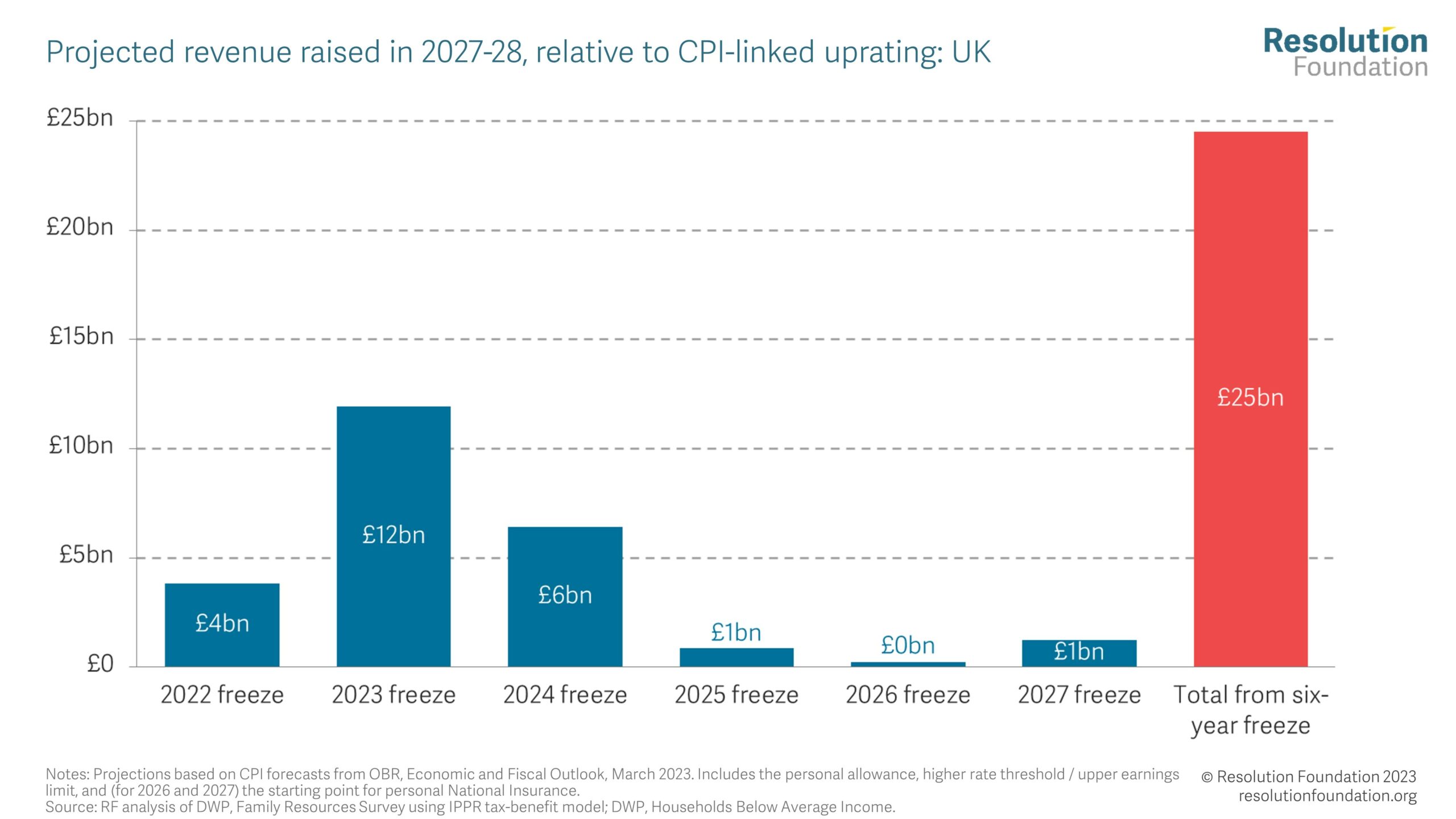
However, while the threshold freeze raises substantial sums relative to the default forecasting assumptions of inflation-linked uprating used by the Treasury and Office for Budget Responsibility, tax bills are not actually rising for individuals (hence the common charge of this being a ‘stealth’ tax rise) and an increase of 10.1 per cent in these tax thresholds would have been considerably faster than average earnings growth. As Figure 4 shows, given what’s happened with earnings, as well as a rollercoaster of National Insurance changes that resulted in a higher threshold, we do not project a dramatic change in the effective tax rate of the typical employee. Although the personal allowance freeze will gradually increase effective tax rates as earnings rise (with, according to the OBR, the freeze meaning an extra 3.2 million people will pay some Income Tax), it might not be until 2027 that the effective tax rate for a typical earner reaches the recent high point it attained briefly in Q2 2022 when the National Insurance rate rise (the Health and Social Care Levy precursor) was in place, but the compensating National Insurance threshold rise had not yet come in.
Figure 4: The effective tax rate for a typical employee is not set to change dramatically in 2023-24, but is on an upward path due to frozen tax thresholds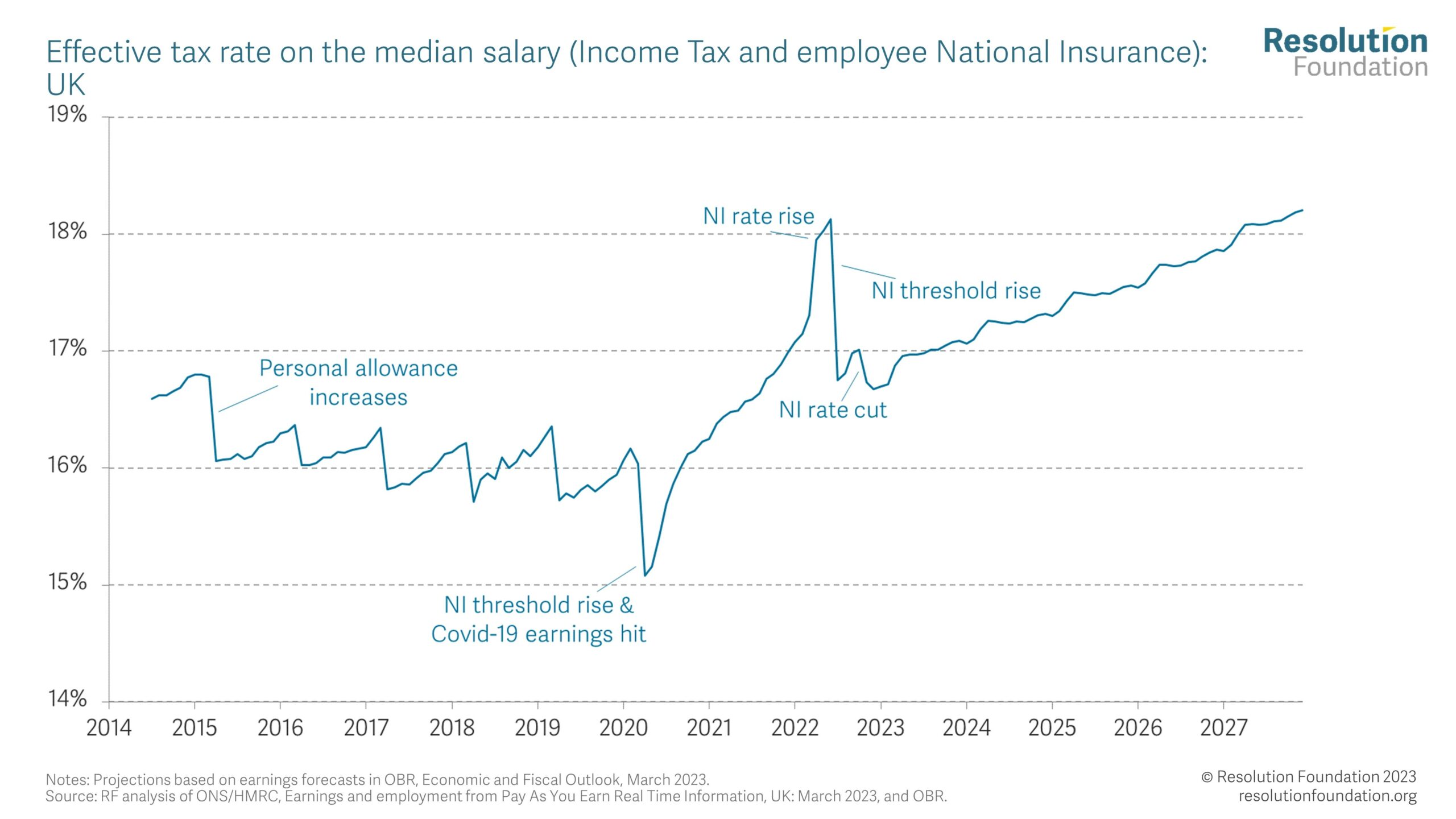
Scrapping the Health and Social Care Levy and instead relying on threshold freezes to raise revenue means that more of the rise in personal taxes is coming more lower-income households. The frozen personal allowance means a basic-rate taxpayer is paying £250 more in Income Tax in 2023-24 relative to normal uprating: this is 1.7 per cent of a gross income of £15,000 but only 0.5 per cent for someone on £50,000. However, on a household basis, and including the higher-rate threshold freeze and other tax rises, this year’s major personal tax changes are broadly progressive – as the right panel of Figure 5 demonstrates (and increases in Corporation Tax, Capital Gains Tax, Inheritance Tax and more would add to that).
Figure 5: 2023’s personal tax rises are broadly (but not particularly) progressive, but Cost of Living Payments are a major intervention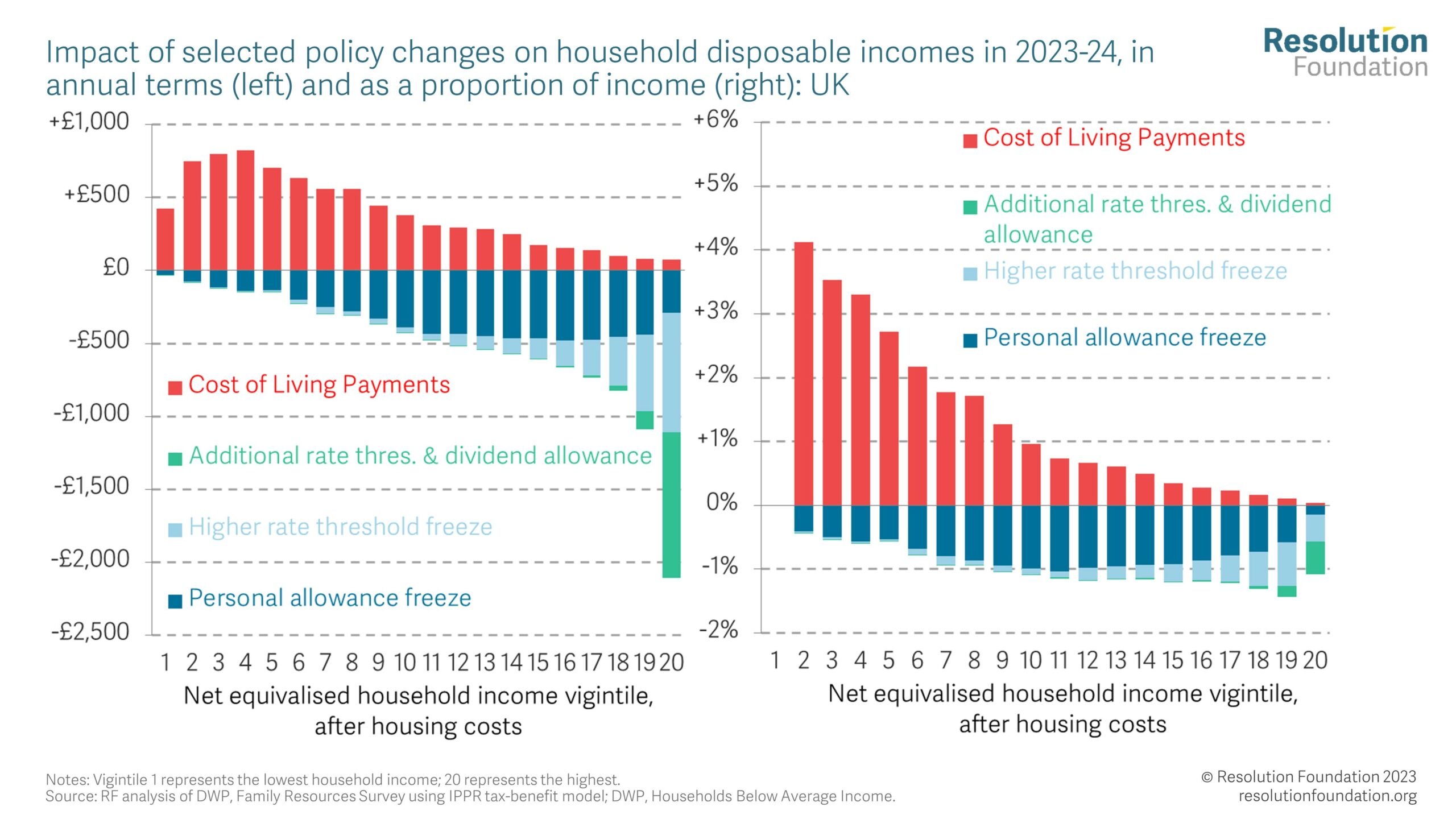
Overall, policies planned for 2023-24 do provide significant cushioning for lower-income households (as shown in our projections for incomes and poverty), while reducing the deficit. But the changes also highlight long-term policy problems, with cost of living payments primarily needed to make up for lagged uprating and an inadequate basic safety net, and tax rises now relying heavily on threshold freezes and Council Tax rises.
[1] For threshold freeze costings, our counterfactual scenario includes raising the starting point for National Insurance in 2026-27 and 2027-28 but not in earlier years, where we maintain it at £12,570, in keeping with the threshold rise policy announced at Spring Statement 2022.
